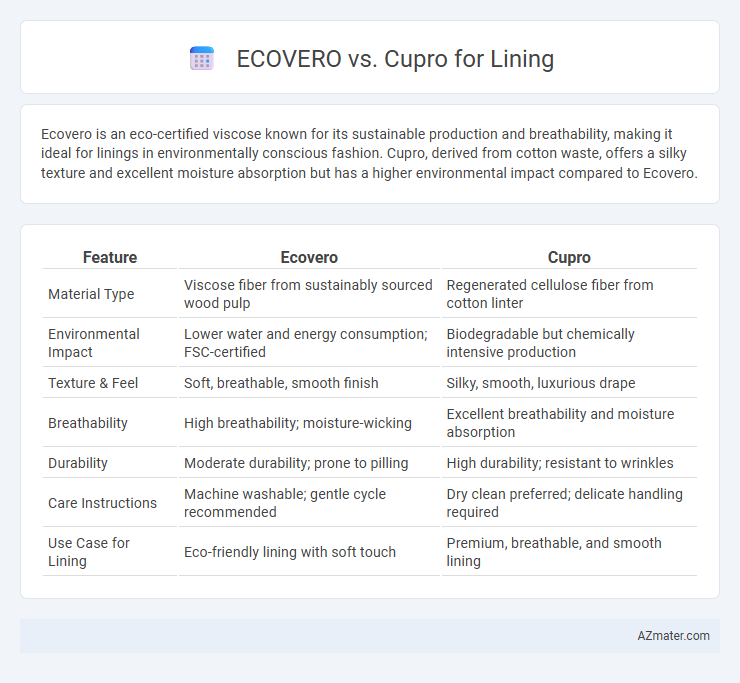Ecovero is an eco-certified viscose known for its sustainable production and breathability, making it ideal for linings in environmentally conscious fashion. Cupro, derived from cotton waste, offers a silky texture and excellent moisture absorption but has a higher environmental impact compared to Ecovero.
Table of Comparison
| Feature | Ecovero | Cupro |
|---|---|---|
| Material Type | Viscose fiber from sustainably sourced wood pulp | Regenerated cellulose fiber from cotton linter |
| Environmental Impact | Lower water and energy consumption; FSC-certified | Biodegradable but chemically intensive production |
| Texture & Feel | Soft, breathable, smooth finish | Silky, smooth, luxurious drape |
| Breathability | High breathability; moisture-wicking | Excellent breathability and moisture absorption |
| Durability | Moderate durability; prone to pilling | High durability; resistant to wrinkles |
| Care Instructions | Machine washable; gentle cycle recommended | Dry clean preferred; delicate handling required |
| Use Case for Lining | Eco-friendly lining with soft touch | Premium, breathable, and smooth lining |
Introduction to Ecovero and Cupro Fabrics
Ecovero fabric, made from sustainably sourced wood pulp, offers eco-friendly properties such as reduced environmental impact and breathable comfort, making it ideal for linings in fashion. Cupro, a regenerated cellulose fiber derived from cotton linter, provides a silky, smooth texture with excellent moisture absorption and breathability, enhancing the feel of garment interiors. Both fabrics support sustainable fashion, but Ecovero emphasizes resource efficiency while Cupro highlights luxurious softness and biodegradability.
What is Ecovero? Key Features for Linings
Ecovero is a sustainable viscose fiber produced from certified renewable wood sources, known for its lower environmental impact compared to conventional viscose. For linings, Ecovero offers excellent breathability, softness, and colorfastness, ensuring comfort and durability in garments. Its eco-friendly production process reduces water and energy consumption, appealing to brands committed to sustainability without compromising fabric quality.
What is Cupro? Key Features for Linings
Cupro is a regenerated cellulose fiber derived primarily from cotton linter, known for its smooth, silky texture and high breathability, making it ideal for linings in garments. Its moisture-wicking properties help keep the fabric dry, while its natural biodegradability offers an eco-friendly alternative to synthetic linings. Cupro's excellent drape and hypoallergenic qualities provide comfort and luxury, distinguishing it from other lining materials like Ecovero, which is a sustainable viscose fiber made from certified wood pulp.
Sustainability Comparison: Ecovero vs Cupro
Ecovero fibers are derived from sustainably managed wood sources certified by the Forest Stewardship Council (FSC), featuring a lower carbon footprint and reduced water consumption compared to conventional viscose. Cupro, made from regenerated cotton linter, uses biodegradable materials and employs a closed-loop production process that recycles water and chemicals, minimizing environmental impact. While both offer eco-friendly alternatives for lining fabrics, Ecovero emphasizes sustainable forestry management, whereas Cupro focuses on recycling waste cotton and efficient resource use.
Comfort and Breathability Differences
Ecovero and Cupro linings differ significantly in comfort and breathability, with Ecovero offering enhanced moisture-wicking properties due to its viscose fibers derived from sustainable wood sources. Cupro, made from regenerated cotton linter, provides a silky smooth texture that feels luxuriously soft against the skin, promoting breathability through its fine fiber structure. The eco-friendly production of Ecovero improves moisture management, while Cupro's open-weave microstructure allows superior air circulation, making both materials ideal for comfortable, breathable linings in high-quality garments.
Durability and Care Requirements
Ecovero linings offer excellent durability with resistance to fading and shrinking, making them suitable for long-lasting garments, while their easy-care properties allow machine washing at low temperatures. Cupro linings provide a luxurious feel and good breathability but require more delicate handling, including hand washing or dry cleaning to maintain fabric integrity and prevent damage. Choosing between Ecovero and Cupro depends on the need for durable, low-maintenance linings versus premium texture with careful care.
Environmental Impact: Ecovero vs Cupro
Ecovero fibers are produced from certified sustainable wood sources with a reduced water and carbon footprint, making them an eco-friendly option for lining materials. Cupro, derived from recycled cotton linter waste, offers biodegradability but involves intensive chemical processing that impacts its overall environmental profile. Comparing both, Ecovero's certified sustainable forestry and lower emissions present a greener choice, while Cupro's recycling benefits are counterbalanced by its chemical treatment requirements.
Cost Considerations for Linings
Ecovero fibers generally offer a more cost-effective option for linings compared to Cupro, due to their sustainable production process and availability. Cupro, made from regenerated cotton cellulose, tends to have higher manufacturing costs which reflect in its premium pricing for luxury linings. Choosing Ecovero for linings balances performance and environmental impact while maintaining budget-friendly pricing for apparel manufacturers.
Best Applications for Each Material
Ecovero, a sustainable viscose made from certified renewable wood sources, excels in linings for eco-conscious fashion and lightweight garments due to its breathability and softness. Cupro, derived from regenerated cotton linter fibers, offers superior drape and a silk-like finish, making it ideal for luxury linings in high-end suits and delicate apparel. Selecting Ecovero ensures environmental benefits and moisture-wicking properties, while Cupro delivers elegance and durability for premium garment construction.
Which Is Better for Lining: Ecovero or Cupro?
Ecovero and Cupro are both sustainable fabric options commonly used for linings, with Ecovero derived from certified sustainable wood pulp and Cupro made from regenerated cotton fibers. Ecovero offers superior moisture management and a softer hand feel, making it ideal for breathable, comfortable linings in high-end garments. Cupro excels in durability and a silky finish but may retain more moisture, positioning Ecovero as the better choice for eco-friendly, breathable linings.

Infographic: Ecovero vs Cupro for Lining
 azmater.com
azmater.com